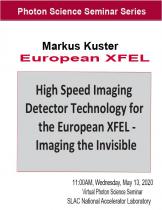Speaker: Markus Kuster, European XFEL
Program Description;
The European X-ray Free Electron Laser is a third generation high brilliance X-ray light source in area of Hamburg/Schenefeld, Germany, which commenced user operation at its first photon beam line in September 2017. The facility provides spatially coherent ultra short X-ray pulses (< 100 fs) in the energy range between 0.25 keV and 25 keV. The up to 27.000 X-ray pulses per second are delivered by the machine in a unique time structure consisting of up to 2700 X-ray pulses at the repetition rate of 4.5 MHz, organized in 10 equidistant pulse trains 10 times per second.
The large variety of scientific applications at the European XFEL require different instrumentation, in particular large area 2D imaging detectors based on hybrid pixel technology, which can cope with high pulse repetition rate of 4.5 MHz, can provide a dynamic range of up to 100.000 photons per pulse per pixel and high angular resolution. The imaging detectors’ on-sensor memory-cell and multi-gain architectures pose unique challenges in detector-specific data corrections and subsequent calibration of scientific data.
I will present an overview about the detector technology in use at the European XFEL and provide an outlook to future detector technology needs.





